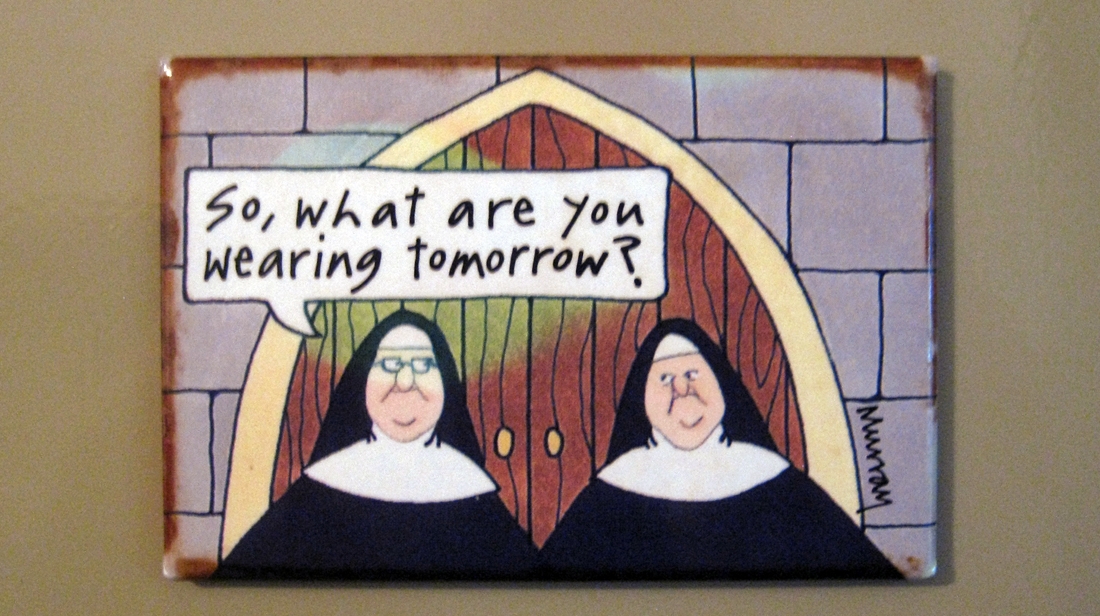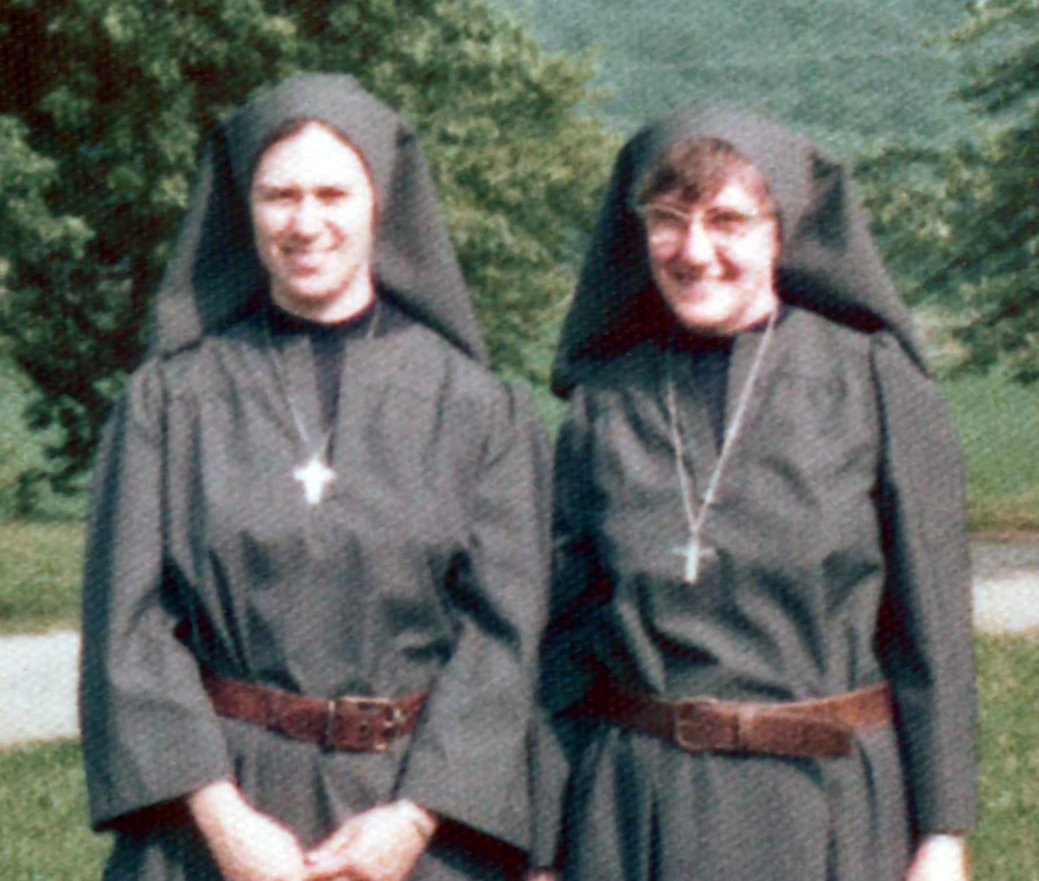Religious Habit

Among other things, the Little Sisters of Jesus and Mary are noted for wearing their habit, a distinctive blue dress with a matching veil. Article 11 of their Constitutions states:
An exterior sign of our consecration is the religious habit of our congregation. It must be worn at all times. Exceptions to this rule must come from the superior general or be stated in the directives. (1)
The decision to wear a habit was crystal clear to the founder of the Little Sisters, Sr. Mary Elizabeth Gintling. She once told the story of how she came upon the design:
We wanted to pattern our lives after Br. Charles de Foucauld, and I said ‘We will have a habit.’ It’s a calling card. It’s a witness. And during the ’60s, it was a counter-culture thing for us to do. We wanted something that would be simple, non-threatening to the poor. (2)
Inspiration struck in a department store when she spied a mannequin dressed in a bright orange satin evening gown:
‘There it is,’ I told Sr. Patricia and she just looked at me like I was crazy. But I told her, ‘Just look at it. It’s perfect. It has no zippers, no buttons, just a hole to put your head through.’ We found the Vogue pattern and bought different sizes and then bought some blue denim material. (2)
Sister elaborated on her choice of the design:
I was determined, knowing how few people sew these days and how hard it would be if we didn’t have somebody in the community who could make our own habits. So I was determined that it was going to be something with no buttons, button holes, zippers [laughter] and nothing difficult about it. (3)
Blue denim-like material seems to be the established “look” for communities of women who follow the spirituality of Br. Charles. Is the color a nod to the beautiful virtues of the Virgin Mary? Is the material a sign of unity with the working people of the world? Yes and yes.
The habit designed by Sr. Mary Elizabeth is an adaptation of the one worn by the Little Sisters of Jesus, the first women’s community inspired by Charles de Foucauld (they were founded by Madeleine Hutin in 1939). Srs. Mary Elizabeth and Patricia Guidera spent time with the Little Sisters of Jesus in Washington, D.C. in June of 1974.
Sr. Mary Elizabeth recalled that encounter:
I guess that was when I asked them if they would help us. Also, I told them about the fact that I felt called to follow Brother Charles and wanted to know if that would be any kind of a threat to them. And that we wanted to wear a habit and wanted to be recognized as belonging to the de Foucauld family. Told them that our habit would look somewhat like theirs but would not be made the same. Wanted to know if that would be OK by them.
And they were extremely good to us. The provincial said that they never saw Brother Charles anymore than I have. [laughter] And that there was no monopoly on whether or not someone looked like them, and that we should just follow whatever we thought God wanted us to do. I felt very at ease with them. (3)
The following July 7, Abbot Edward McCorkell, O.C.S.O. blessed the habits of the new community at the Abbey of the Holy Cross in Berryville, Virginia. The Little Sisters of Jesus and Mary consider this their Foundation Day.

Bea Piekarski, a friend and volunteer from Baltimore, made the first habits. Later modifications included using a simpler, lighter belt, re-doing the front placket to make the wearing of a dickey around the collar unnecessary, and removing the cap inside the veil.
A small wooden cross necklace completes the habit. When a Little Sister makes final vows, an image of the Crucified Christ is engraved on the cross.
In years past, the Little Sisters also wore a leather “heart and cross” insignia on the chest. Attached by velcro, it invariably peeled off whenever a Little Sister was carrying a load of boxes. Sr. Mary Elizabeth finally said “Enough!” and the insignia was removed from the habit permanently.

Wearing a habit was crucial to Sr. Mary Elizabeth’s understanding of religious life. She always defended her decision to make it a requirement for the Little Sisters:
I felt that people who wanted to wear habits should feel free to wear the habit. And I can tell you right now it took us more courage to put on that habit than it did to make vows because everybody criticized us for wearing a habit. Here you are, in the middle of an effort for all the nuns to get some freedom and dress like the people today and you’re putting on a habit. And I said it’s because I believe in habits. And I intend to keep the freedom to wear one.
So it was very important to us, it indeed was. I still see the importance of it. I have never lost that because it’s what tells people who you are, which is very important. (3)
Of course, Sr. Mary Elizabeth understood that clothes do not make the man, or nun. She wrote in the Joseph House Newsletter:
She [the Little Sister] will always be a visible sign to those with whom she works, not only by her habit, but also by her actions. (4)
And in her directives concerning the Rule:
The habit makes us mindful of who we are, but does not make us who we are. (3)
The habit is a way to be in the world, but not of it. For the Little Sisters, the habit encapsulates their mission and lifestyle. As Sr. Mary Elizabeth explained:
That’s our vocation, to cry out the Gospel with our lives. We wanted to be poor, but we also wanted to identify our poverty with our vocation. So we designed a simple blue habit that makes it clear that what we do, we do for love of Jesus.
We don’t hide behind our habits. The poor recognize us and know that we are just as poor as they. The habits also keep us from getting caught up in materialistic pursuits. (5)
The habit is a witness of total dedication to Christ and a counter-cultural protest against the materialism of today:
It spares us having to keep up with current styles and having to be immodest to be in style. It says who we are and what we stand for. (3)
Women in formation to become Little Sisters of Jesus and Mary wear a variation of the habit. They start out with a simple uniform of a blue jumper, white blouse, and light blue veil. After completing the novitiate and professing first vows, they receive the habit.

Regarding the habit, Sr. Mary Elizabeth used to say that whether a Little Sister is going to meet the Pope or mop the floor, she is ready.
Nevertheless, the Little Sisters tend to wear an everyday habit that is soft and a little faded, keeping another habit looking fresh for special occasions.
By the way, bleach was banned in the convent laundry room a long time ago. Accidentally tie-dyed habits are certainly not regulation.
Sr. Mary Elizabeth loved her habit, and she wanted her community of Little Sisters to share that love. She described it as a “peasant look.” Simple, sturdy, no fuss — it is the appropriate attire for a handmaiden of the Lord.
Sr. Mary Elizabeth was buried in her habit. It is her chosen garment for the Resurrection.

SOURCES:
(1) Constitutions and Rule of the Little Sisters of Jesus and Mary.
(2) Zuniga, Marielena. (1985, August 2). Order’s foundress helps ‘poorest of the poor.’ The Dialog, pp. 1,5.
(3) Archives of the Little Sisters of Jesus and Mary.
(4) Joseph House Newsletter, April, 1975.
(5) Brankin, Rev. Patrick. (1987, August/September). A new community grows. Extension, pp. 12-15.

❤️ “Modesty is the color of virtue.” Diogenes